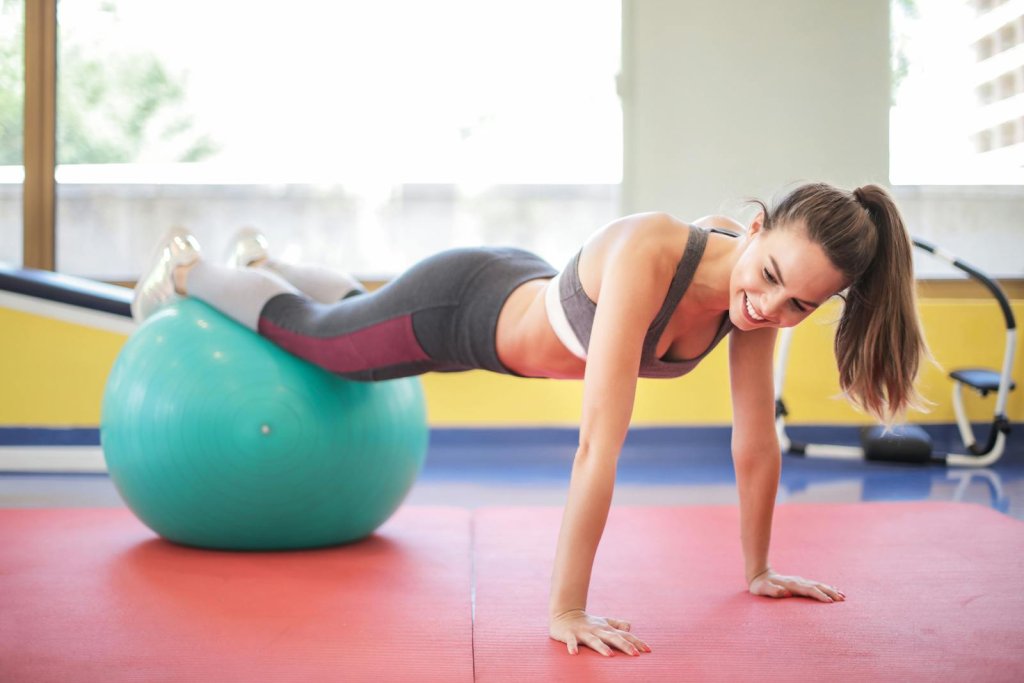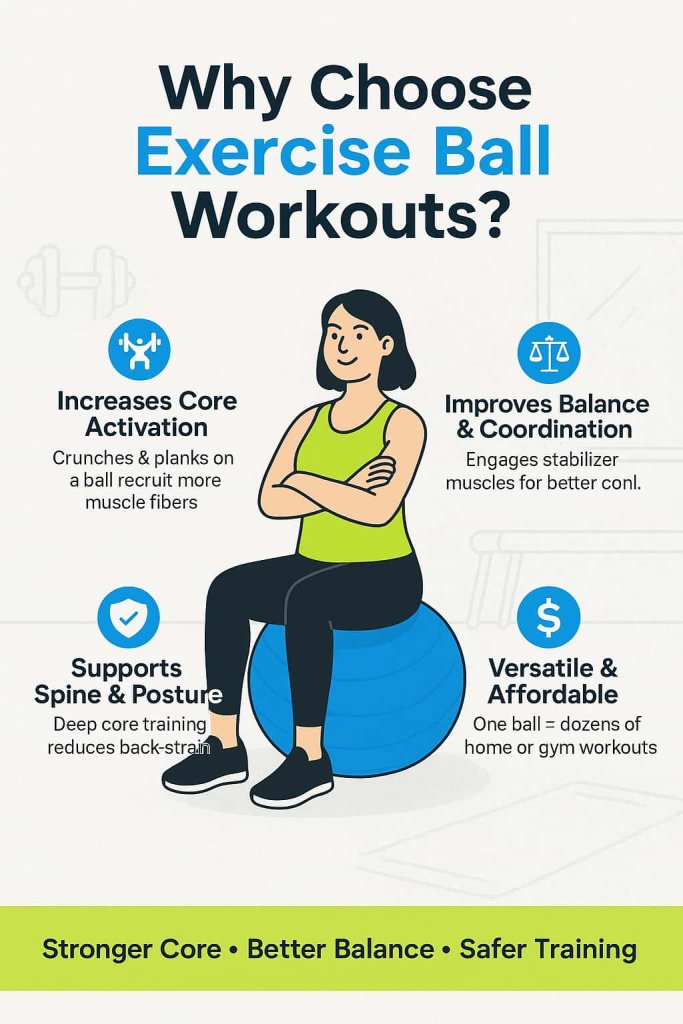Yes, exercise ball workouts are one of the most effective ways to strengthen your core because the unstable surface forces your abs, obliques, and lower back to work harder to maintain balance. Whether you are a beginner or advanced, using a stability ball (also called Swiss ball or physio ball) improves strength, posture, flexibility, and balance.

Understanding how to use an exercise ball safely is key to avoiding injuries and maximizing results. In this guide, you’ll discover the benefits of exercise ball training, 12 proven core moves, safety tips, FAQs, and references.
Why Choose Exercise Ball Workouts?

- Increases Core Activation: Studies show that doing crunches or planks on a ball recruits more muscle fibers than on the floor.
- Improves Balance & Coordination: Training on an unstable surface develops stabilizer muscles that support daily movements.
- Supports Spine & Posture: Engaging deep core muscles reduces back pain risk and supports healthy alignment.
- Versatile & Affordable: One ball offers dozens of exercise variations—ideal for both home and gym workouts.
How to Use an Exercise Ball Safely

- Pick the right size ball: When seated, knees should bend at 90° with feet flat (North Central Surgical, 2025).
- Start with basics: Begin with easy exercises before progressing to advanced moves.
- Move slowly: The ball magnifies small mistakes—control matters more than speed.
- Engage your core: Pull your belly button toward your spine throughout.
- Stop if you feel pain: Especially in your back, shoulders, or hips.
12 Proven Exercise Ball Moves for a Strong Core
1. Stability Ball Crunch
How to do it:
- Sit on the ball with feet flat and walk forward until your lower back rests on the ball.
- Cross arms over chest or place hands lightly behind your head.
- Engage your abs, curl your torso upward, and slowly lower back down.
Benefits:
- Provides a greater range of motion compared to floor crunches.
- Strengthens the rectus abdominis (upper abs).
Trainer Tip: Keep chin slightly tucked; avoid pulling on your neck.
2. Russian Twist on Ball
How to do it:
- Sit on the ball and walk forward slightly so your torso leans back.
- Hold a medicine ball, dumbbell, or clasp your hands together.
- Twist your torso side to side, keeping hips steady.
Benefits:
- Strengthens the obliques.
- Improves rotational stability for sports and daily activities.
Progression: Lift one foot slightly off the ground for an extra challenge.
3. Plank with Feet on Ball
How to do it:
- Place your shins on the ball and hands on the floor in a plank position.
- Keep your body straight from head to heels.
- Hold for 20–60 seconds.
Benefits:
- Engages the entire core and stabilizing muscles.
- Improves posture and shoulder stability.
Safety Tip: Don’t let hips sag; keep glutes tight.
4. Knee Tuck (Ball Roll-In)
How to do it:
- Start in plank position with shins on the ball.
- Pull knees toward chest, rolling the ball forward.
- Extend legs back to plank.
Benefits:
- Targets lower abs and hip flexors.
- Builds dynamic stability.
Progression: Try single-leg knee tucks for more intensity.
5. Ball Pass (Jackknife Pass)
How to do it:
- Lie flat with arms extended, holding the ball overhead.
- Raise arms and legs simultaneously, pass the ball to your feet.
- Lower both arms and legs, then repeat the pass back to your hands.
Benefits:
- Strengthens lower abs.
- Improves hand-to-foot coordination.
Trainer Tip: Keep lower back pressed into the floor to avoid strain.
6. Reverse Crunch with Ball
How to do it:
- Lie on your back and place the ball between your calves or ankles.
- Lift legs toward chest, squeezing the ball.
- Slowly lower with control.
Benefits:
- Builds lower abdominal strength.
- Improves control and pelvic stability.
Progression: Extend legs straight out instead of bent for added difficulty.
7. Hamstring Curl on Ball
How to do it:
- Lie on your back with calves resting on the ball.
- Lift hips off the floor into a bridge.
- Pull the ball toward glutes using your heels, then extend back out.
Benefits:
- Strengthens hamstrings, glutes, and lower back.
- Engages core stabilizers for balance.
Trainer Tip: Keep hips lifted throughout for maximum effect.
8. Dead Bug with Ball
How to do it:
- Lie on back, pressing the ball between knees and hands.
- Extend opposite arm and leg while keeping the ball stable.
- Return to start and switch sides.
Benefits:
- Trains deep stabilizers (transverse abdominis).
- Enhances coordination and motor control.
Safety Tip: Move slowly and keep lower back pressed into floor.
9. Ball Pike
How to do it:
- Start in plank with feet on the ball and hands on the floor.
- Engage core and lift hips upward into a pike position.
- Lower back to plank with control.
Benefits:
- Builds powerful lower and upper ab strength.
- Trains shoulder stability.
Progression: Perform single-leg pikes for advanced control.
10. Side Plank with Ball
How to do it:
- Place forearm on the ball and stack feet or place them on the ball.
- Lift hips, holding a straight line from head to heels.
- Hold for 15–30 seconds each side.
Benefits:
- Strengthens obliques and lateral stabilizers.
- Improves balance and spinal alignment.
Safety Tip: Keep shoulder stacked directly over elbow.
11. Sit-Up on Ball
How to do it:
- Sit on the ball and walk feet forward until lower back rests on the ball.
- Cross arms over chest or hold light weights.
- Perform a controlled sit-up and lower back down.
Benefits:
- Greater range of motion than floor sit-ups.
- Builds endurance in upper and mid-abs.
Trainer Tip: Keep feet firmly planted for stability.
12. Overhead Squat with Ball
How to do it:
- Stand tall holding the ball overhead with arms extended.
- Lower into a squat, keeping chest lifted and core engaged.
- Push through heels to return to standing.
Benefits:
- Strengthens entire core through bracing.
- Builds leg and shoulder endurance.
Progression: Use a medicine ball or add light weights for more resistance.
Sample Exercise Ball Core Workout Plan
Warm-Up (3 minutes)
- Seated balance on ball – 30 seconds
- Torso twists and arm circles – 30 seconds each
Main Workout (Repeat 2 Rounds):
- Stability Ball Crunch – 12 reps
- Russian Twist – 10 reps each side
- Plank with Feet on Ball – 20–30 sec hold
- Knee Tuck Roll-In – 12 reps
- Hamstring Curl – 12 reps
- Ball Pike – 8–10 reps
Finisher (Optional):
- Dead Bug with Ball – 30 seconds
- Sit-Up on Ball – 12 reps
Cool-Down (2–3 minutes)
- Cat-cow stretch over ball
- Seated forward fold on ball
👉 Do this 2–3 times per week for best results.
Common Mistakes to Avoid with Exercise Ball Training
- Using the wrong size ball
- Arching lower back during crunches or planks
- Moving too quickly and losing balance
- Holding breath instead of exhaling on effort
- Forgetting to engage the core
- Skipping warm-up stretches
Who Should (and Shouldn’t) Use Exercise Ball Workouts?
Best For:
- Beginners building core strength
- Seniors looking for gentle balance training
- Athletes needing dynamic stability
- Office workers correcting posture
- Physical therapy patients (under supervision)
Caution or Avoid:
- People with serious back injuries or herniated discs
- Anyone with severe balance issues (unless supervised)
- Pregnant women in later trimesters
- Those with vertigo or dizziness
Tips for Getting the Best Results
- Perform 2–3 sets of 8–15 reps for most moves.
- Train your core 2–3 times per week (CDC recommends strength training at least twice weekly).
- Combine with cardio and full-body training for overall fitness.
- Add progression: wider stance → narrow stance → single leg or add weight.
FAQs about Exercise Ball Workouts
1. What size exercise ball should I use?
Choose based on your height. For example, 55 cm for under 5’5”, 65 cm for 5’6”–6’0”, and 75 cm for over 6’1”.
2. Are exercise ball workouts safe for beginners?
Yes—start with simple moves like ball crunches or seated balance holds, then progress.
3. Can exercise ball training reduce belly fat?
It strengthens abs, but fat loss requires a calorie deficit through diet and overall activity.
4. How often should I train with a stability ball?
2–3 sessions per week is enough to see core improvements.
5. Is the exercise ball good for lower back pain?
Yes—when used correctly, it can strengthen stabilizers and support posture. Always check with a doctor if you have back issues.
6. Do I need gym membership for these exercises?
No—you only need a ball, which makes it ideal for home workouts.
7. Can seniors use an exercise ball?
Yes, but start with gentle moves and ensure proper stability. A wall or sturdy support nearby is recommended.
Conclusion
Exercise ball workouts are a powerful, low-cost way to build a strong core, improve posture, and support overall fitness. By adding these 12 proven moves into your weekly routine, you’ll not only sculpt your abs but also improve balance, stability, and everyday strength.
👉 Grab an exercise ball today and start with just 10–15 minutes, 2–3 times per week. Small steps lead to big gains in core strength and stability.
